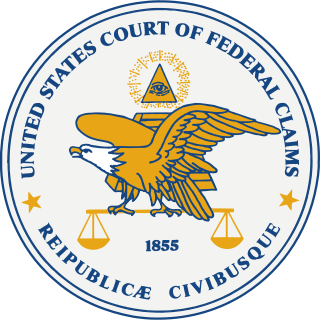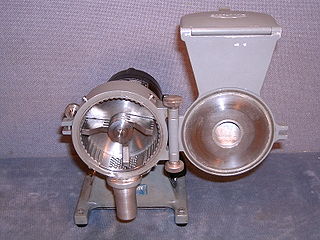In the law of the United States, attorney–client privilege or lawyer–client privilege is a "client's right privilege to refuse to disclose and to prevent any other person from disclosing confidential communications between the client and the attorney."
In United States patent law, utility is a patentability requirement. As provided by 35 U.S.C. § 101, an invention is "useful" if it provides some identifiable benefit and is capable of use. The majority of inventions are usually not challenged as lacking utility, but the doctrine prevents the patenting of fantastic or hypothetical devices such as perpetual motion machines.
In United States patent law, the reduction to practice is the step in the formation of an invention beyond the conception thereof. Reduction to practice may be either actual or constructive. The date of reduction to practice was critical to the determination of priority between inventors in an interference proceeding under the discontinued first-to-invent system as well as for swearing behind a reference under that system.
In United States trademark law, the functionality doctrine prevents manufacturers from protecting specific features of a product by means of trademark law. There are two branches of the functionality doctrine: utilitarian functionality and aesthetic functionality. The rationale behind functionality doctrine is that product markets would not be truly competitive if newcomers could not make a product with a feature that consumers demand. Utilitarian functionality provides grounds to deny federal trademark protection to product features which do something useful. Patent law, not trademark, protects useful processes, machines, and material inventions. Patented designs are presumed to be functional until proven otherwise. Aesthetic functionality provides grounds to deny trademark protection to design features which are included to make the product more aesthetically appealing and commercially desirable. Aesthetic features are within the purview of copyright law, which provides protection to creative and original works of authorship.
Candy and Chocolate Confections, Federal Specification Z-C-2104, is a document that defines and outlines requirements for candy and chocolates that the United States federal government may use, and further defines the conditions under which a new type of candy may be found suitable for use by government agencies. Specification Z-C-2104 was first enacted in 1979 by the Federal Supply Service, part of the Federal Acquisition Service, which in turn is part of the General Services Administration.
Quanta Computer, Inc. v. LG Electronics, Inc., 553 U.S. 617 (2008), is a decision of the United States Supreme Court in which the Court reaffirmed the validity of the patent exhaustion doctrine, and in doing so made uncertain the continuing precedential value of a line of decisions in the Federal Circuit that had sought to limit Supreme Court exhaustion doctrine decisions to their facts and to require a so-called "rule of reason" analysis of all post-sale restrictions other than tie-ins and price fixes. In the course of restating the patent exhaustion doctrine, the Court held that the exhaustion doctrine is triggered by, among other things, an authorized sale of a component when the only reasonable and intended use of the component is to practice the patent and the component substantially embodies the patented invention by embodying its essential features. The Court also overturned, in passing, the part of decision below that held that the exhaustion doctrine was limited to product claims and did not apply to method claims.

Pauline Newman is a United States Circuit Judge of the United States Court of Appeals for the Federal Circuit.

Fonar Corp. v. General Electric Co., 107 F.3d 1543, was a case decided in 1997 by the United States Court of Appeals for the Federal Circuit concerning source code and the disclosure requirement for software patents.
An equitable adjustment, in government contracting, is a contract adjustment pursuant to a changes clause, to compensate the contractor expense incurred due to actions of the Government or to compensate the Government for contract reductions. An equitable adjustment includes an allowance for profit; clauses that provide for adjustments, excluding profit, are not considered "equitable adjustments."
CEMS, Inc. v. United States, 59 Fed. Cl. 168 was a government contracting suit before the United States Court of Federal Claims. It deals with the requirements for a contractor to receive an equitable adjustment for work outside the contract.
A changes clause, in government contracting, is a required clause in United States government construction contracts.

Netscape Communications Corp. v. Konrad, 295 F.3d 1315, was a decision of the United States Court of Appeals for the Federal Circuit. It affirmed that public use or commercialization of an invention more than one year prior to the filing date will cost the inventor his patent rights. The inventor in this case was Allan M. Konrad, a Lawrence Berkeley National Laboratory employee who devised and implemented a method for accessing and searching data objects stored on a remote computer. Netscape moved to invalidate Konrad's patents in U.S. district court immediately after Konrad filed a patent infringement suit against Netscape customers. The district court concluded that Konrad's patents were invalid because they did not meet the public-use and on-sale bar eligibility criteria of 35 U.S.C. § 102b.
In particular, the district court found that Konrad (1) placed his invention in the public domain by demonstrating it to others without a confidentiality agreement and (2) tried to sell it to other legal entities, both more than one year before he filed for the patent. The appeals court, upon review, affirmed the district court decision for the same reasons.

G.L. Christian and associates v. United States is a 1963 United States Federal Acquisition Regulation (FAR) court case which has become known as the Christian Doctrine. The case held that standard clauses established by regulations may be considered as being in every Federal contract. Because the FAR is the law, and government contractors are presumed to be familiar with the FAR, a mandatory clause that expresses a significant or deeply ingrained strand of public procurement policy will be incorporated into a Government contract by operation of law, even if the parties intentionally omitted it.
United States v. Spearin, 248 U.S. 132 (1918), also referred to as the Spearin doctrine, is a 1918 United States Supreme Court decision. It remains one of the landmark construction law cases. The owner impliedly warrants the information, plans and specifications which an owner provides to a general contractor. The contractor will not be liable to the owner for loss or damage which results solely from insufficiencies or defects in such information, plans and specifications.

The United States was the first jurisdiction to acknowledge the common law doctrine of aboriginal title. Native American tribes and nations establish aboriginal title by actual, continuous, and exclusive use and occupancy for a "long time." Individuals may also establish aboriginal title, if their ancestors held title as individuals. Unlike other jurisdictions, the content of aboriginal title is not limited to historical or traditional land uses. Aboriginal title may not be alienated, except to the federal government or with the approval of Congress. Aboriginal title is distinct from the lands Native Americans own in fee simple and occupy under federal trust.
Walker Process Equipment, Inc. v. Food Machinery & Chemical Corp., 382 U.S. 172 (1965), was a 1965 decision of the United States Supreme Court that held, for the first time, that enforcement of a fraudulently procured patent violated the antitrust laws and provided a basis for a claim of treble damages if it caused a substantial anticompetitive effect.
General Dynamics Corp. v. United States, 563 U.S. 478 (2011), is a U.S. Supreme Court case in which the State Secrets Privilege prevented the plaintiff from using the evidence it needed to protect itself from an expensive judgement.
The reverse doctrine of equivalents is a legal doctrine of United States patent law, according to which a device that appears to literally infringe a patent claim, by including elements or limitations that correspond to each element or limitation of the patent claim, nonetheless does not infringe the patent, because the accused device operates on a different principle. That is, "it performs the same or a similar function in a substantially different way." It has been said that "the purpose of the ‘reverse’ doctrine is to prevent unwarranted extension of the claims beyond a fair scope of the patentee’s invention."
Government patent use law is a statute codified at 28 USC § 1498(a) that is a "form of government immunity from patent claims." Section 1498 gives the federal government of the United States the "right to use patented inventions without permission, while paying the patent holder 'reasonable and entire compensation' which is usually "set at ten percent of sales or less". This statute "allows federal agencies and thirdparty government contractors to manufacture and/or use any invention without authorization from the patent holder. The federal government's rights are without an obligation for prior negotiation." Although Congress has the right to waive sovereign immunity for alleged patent infringement claims under the 'government patent use' statute, there are limits to the patent holder's recourse in the United States Court of Federal Claims.








